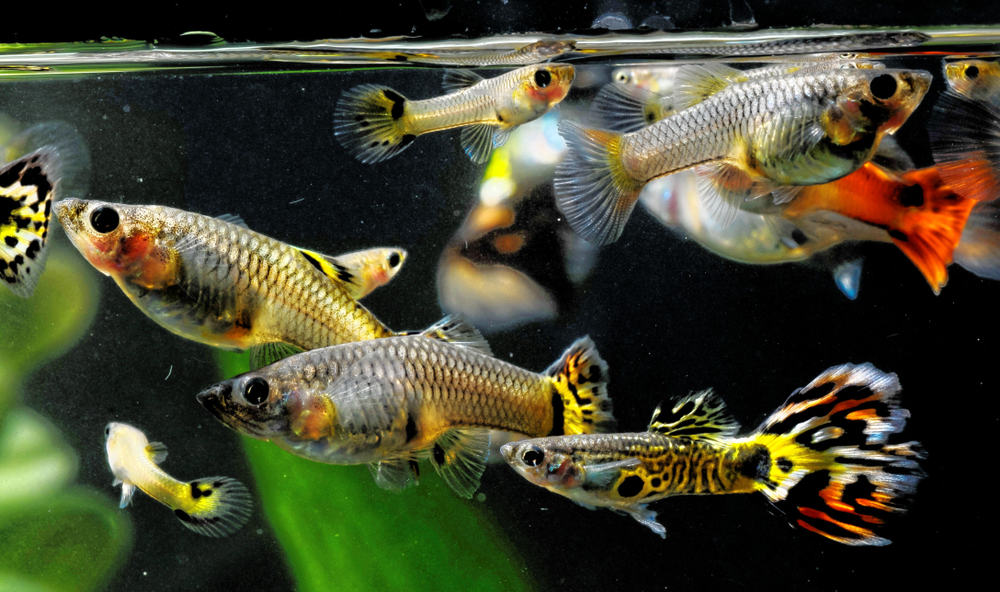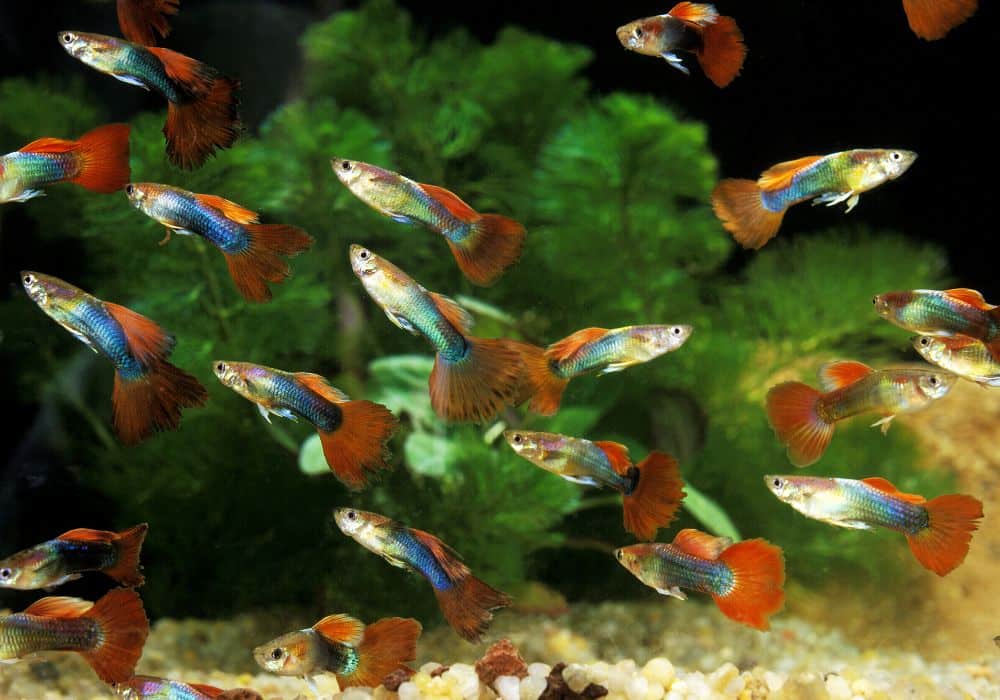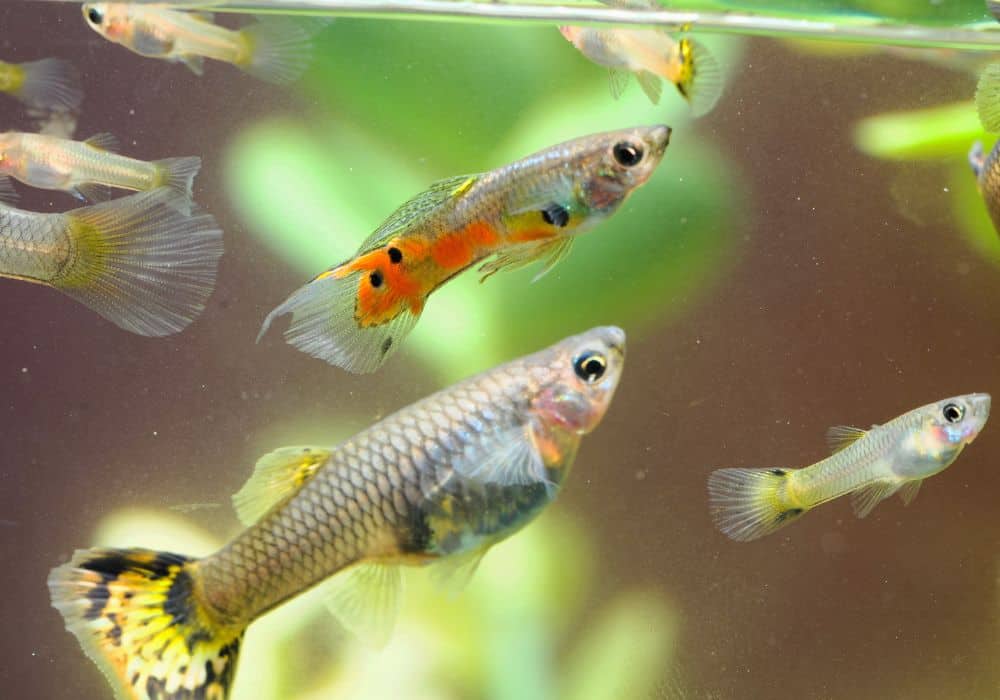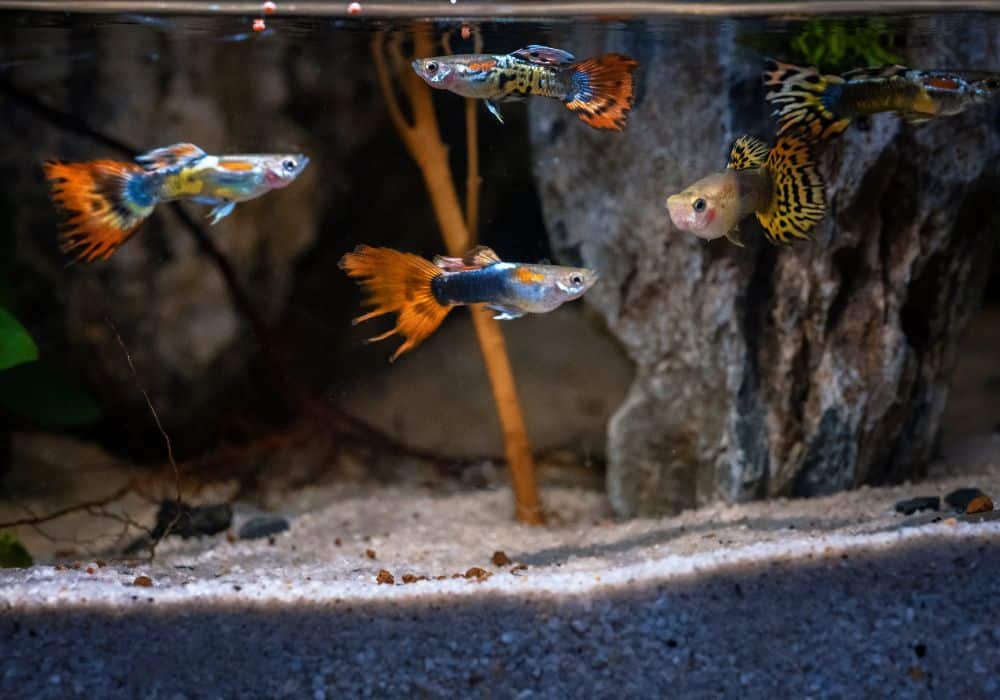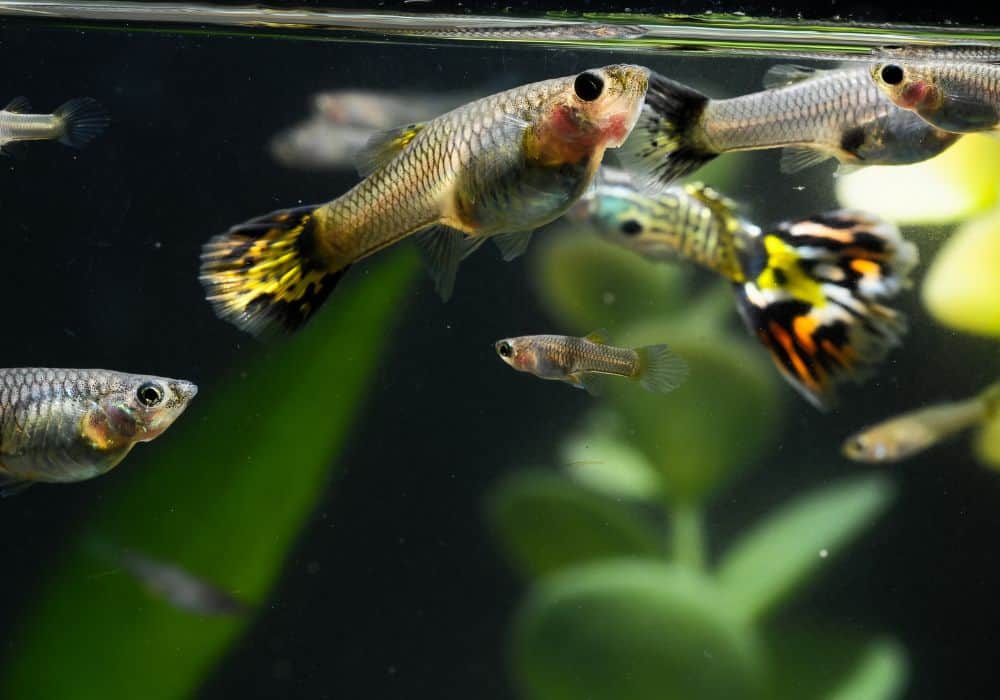Are you looking for the perfect fish to add to your home aquarium? Look no further than guppies! Known for their beautiful fins and colorful bodies, guppies are some of the most common tropical aquarium fish to keep as pets.
Guppies are low-cost, low-maintenance, and easy to care for, making them the perfect fish for beginners. Just be sure to maintain a comfortable tank environment for them, following all tank requirements consistently.
Want to learn more about domestic and wild guppies? Continue reading to learn what guppies eat, where they live, and more.
What Are Guppies?
Known sometimes by their scientific name, Poecilia reticulata, guppies are small tropical fish that are found in many parts of the world. They also one of the most common fish that people keep as pets in their home aquariums.
Guppies are very small compared to other fish, ranging from 0.6 to 2.4 inches in size and less than one gram in weight. As for their physical characteristics, guppies are most known for their colorful scales and flowing fins. In fact, guppies come in a variety of colors, including yellow, orange, blue, red, green, pink, and even multi-colored.
These shy fish often live in large groups called schools in order to protect themselves against all of nature’s predators, including bigger fish and sea birds. In general, guppies prefer a freshwater environment, however, they can easily adapt to brackish waters.
Guppies can be found in streams and shallow waters around the world – mainly in the waters of South America, Antigua, Trinidad, and more – as well as in the tanks of fish owners around the world.
What Do Guppies Eat in Captivity?
As the owner of guppies, you’ll find that it is best to feed them a combination of fish food, including flakes, freeze dried foods, and vegetation, to provide them with all the minerals and vitamins that they need.
While feeding them a combination of different types of food, you should make sure to only feed them a small amount of food. Guppies have much smaller stomachs than most fish, so overfeeding them can cause discomfort and block their intestines. It is best to feed them in small quantities.
Here are some more details on the foods they should be eating in captivity, to make sure they have a well-rounded and healthy diet.
Fish Flake Food
For guppies that live in captivity, the main component of their diet is fish flake food. But you won’t necessarily want to feed them just any flake food. Your flake food options for your pet guppy are flake food made specifically for tropical fish or a quality flake food.
Because guppies are so small, you should always avoid feeding them pellets.
Freeze-Dried Foods
There is a variety of freeze-dried foods that can be fed to guppies in captivity, including brine shrimp, bloodworms, and daphnia. Freeze-dried foods are a great option for adding variety to your guppy’s diet.
Vegetation
Because guppies are omnivores, plants and greens are a big part of their diet. So, adding vegetation to the diet of a guppy in captivity will give these fish additional nutrients that they may not get from the flake food.
This is a great thing to keep in mind when deciding on what you want to feed your own guppies in captivity. Some vegetation to consider adding to your pet’s diet include lettuce, peas, green beans, cabbage, kale, and cucumbers.
What Do Guppies Eat in the Wild?
As omnivores, wild guppies eat both plants and meat. The main components of their diet include plant particles, and insect larvae. The eating habits of guppies in the wild depend on the availability of food in their habitat.
Live food can provide a great source of nutrients for guppies in the wild. When available, guppies can often feed on other species like brine shrimp, invertebrates, and insect larvae. Mosquito larvae is an especially great meal for them, as it allows these fish to not only get their nutrition, but also naturally control the population of mosquitos while slowing the spread of malaria.
In the wild, guppies forage, or search, for food in large groups called schools. When the group comes across algae, this just means there is more nourishment to go around.
What Do Baby Guppies Eat?
Baby guppies, also called “guppy fry,” are only one fourth of an inch, or 0.6 mm, in length. Because of this, caring for baby guppies is completely different than caring for fully grown guppies.
Because they are much smaller in size compared to adults, baby guppies can only eat certain foods like crushed fish flakes, frozen dry food, daphnia, or baby bring shrimp. The key thing to remember when feeding baby guppies is to only give the foods that are small enough for them to properly digest.
How Often Should You Feed Guppies?
To be healthy, adult guppies should eat once to twice a day. Baby guppies, however, need to eat more often than adults. Young guppies should eat somewhere between six to eight small meals per day because they need more energy to grow.
It is important not to overfeed these tiny fish, so you should only feed them as many flakes that they can eat in two minutes. Overeating can cause health issues in their small stomachs and can block their intestines.
Uneaten food can release toxins in the water. So, after they finish eating, you should be sure to remove any uneaten food from the water with a net. This will help you maintain the health of your tank and clean high-quality water.
Tips for Caring About Pet Guppies
When buying guppies as pets, you’ll want to create a comfortable environment and tank for them. Although guppies can be found in different bodies of water like streams and ponds, those living in captivity prefer freshwater tanks.
Check out these tips for setting up your home aquarium and maintaining a comfortable environment for your guppies.
Abide by these tank requirements
When picking out a tank, it is recommended to start with a minimum of 10-gallons – the most common starter size tank. Anything less than 10 gallons will be too small, making it too difficult to keep clean.
When putting your tank together, you’ll also need to add about two inches of gravel at the bottom of the tank. The gravel will mimic their natural environments in the wild. This will not only add a layer of décor to the tank, but it will also help filter the water and keep it clean.
Decorate your tank to give your guppies enough room to hide
One of the biggest things to keep in mind when setting up your tank is to make sure it is big enough to have plenty of spots for your guppies to hide. So, in addition to adequate size tank, you should also decorate the inside of the tank with décor that can double as a hiding place for your guppy, like plants, ornaments, caves, and structures.
Live plants can be a great addition to your tank, providing both coverage and the perfect hiding spots for your fish. Think about adding a variety of live plants, such as Java moss, flame moss and wisteria. These plants will also serve to keep the water clean through natural processes and cycles.
Keep a warm and comfortable temperature
Water temperature is critical in your guppy tank. It is very important to keep an ideal temperature for your guppies to thrive. If the tank temperature is too hot or too cold, you’re at risk for killing your fish.
An ideal tank temperature for guppies is between 74 to 82 degrees Fahrenheit, or 22 to 28 degrees Celsius. This will most closely mimic the tropical waters that they are native to.
Add smaller fish to keep your guppies company
Guppies are friendly fish, and they can usually get along well with other species of fish. However, the other species of fish that you add to your tank should be small in size and calm in their nature so they can get along well with the guppies.
Even though guppies are small enough to be the perfect prey for many predators in the water, there are some types of fish that can live in peace and harmony with guppies in the same tank. Specifically, smaller fish like platys or gouramis make great companions for guppies.
Here is a list of other fish species that can make great companions for guppies.
- Cardinal tetras
- Mollies
- Zebra danios
- Cory catfish
- Swordtails
Everything You Need to Know About Guppies
Whether they are in the wild or in your home, guppies are beautiful fish that are easy to care for. So, if you’re looking for a colorful and tropical addition to your home aquarium, guppies are a great option.
There is so much to know about guppies and how to care for them. As a quick recap, here are a few fast and interesting facts about guppies:
- Guppies are tiny fish that are most known for their different colors and patterns, as well as their flowing fins. They come in a variety of colors, which can add vibrancy to any tank.
- There are a few differences between male and female guppies, with females being up to one inch larger in size.
- Female guppies can reproduce often, birthing a litter of 20 to 50 baby guppies about every 30 days. Keep this in mind if you are not looking to add to many fish to your tank.
- Wild guppies play an important role in the fight against malaria. As part of their diet, they eat mosquito larvae, which naturally helps control and decrease the general mosquito population. Less mosquitos leads to less malaria.
If you would like to know anything else about guppies, feel free to leave your questions in the comments section!
FAQs
Now that you know all about guppies and what they eat, are you still curious to learn more? Check out our frequently asked questions (FAQs) for everything you need to know about these little fish.
Where are most wild guppies located?
Guppies can be found in bodies of water around the world, with the exception of Antarctica. These small fish are native to South America as they do best in warm, tropical waters.
In addition, wild guppies can be found in Brazil, Jamaica, Venezuela, the U.S. Virgin Islands, and more. Wild guppies can also live in freshwater and brackish water.
What animals eat wild guppies?
Due to their size, guppies in the wild waters are susceptible to many predators. Wild guppies can be eaten by large fish, such as the blue acara and pike cichlid. They can also be eaten by sea birds, like seagulls and kingfishers.
How much do guppies cost?
In most pet stores, guppies range from $4 to $25, mainly depending on the species and how many you purchase. A good rule of thumb is to buy guppies in groups of at least three. Keeping this in mind, your mini school of guppies can cost between $12 to $75.
How long do guppies live?
The average lifespan of a guppy is just two to three years. However, their lifespan can vary depending on whether they are wild or domesticated. Wild guppies, for example, live two years whereas guppies in captivity can live between two to five years, if they are cared for properly.
What is the difference between male and female guppies?
It is easy to tell the difference between male and female guppies, and you’ll be most able to distinguish them by size. In fact, when they are fully grown, female guppies are about one inch larger than males. In addition, male guppies are slimmer and more colorful than female guppies.
Another fun fact about male and female guppies is that when they are stressed, they tend to change colors. When they are looking for a mate to breed with, males become much brighter in color. Females, on the other hand, become paler and rounder when breeding.
